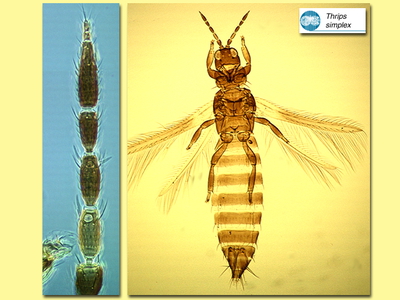Figures
Fig. 1 Antenna and head (dorsal)
Fig. 2 Head (dorsal)
Fig. 3 Pronotum
Fig. 4 Meso- and metanotum
Fig. 5 Fore and hind wing
Fig. 6 Sternite VI
Fig. 7 Tergite VIII (female)
Species
Thrips simplex Morison
Biology
Breeding in the flowers and on the leaves of the Iridaceae plants Gladiolus and montbretia (Crocosmia).
Distribution
Now found throughout the world, but probably originating in southern Africa.
Recognition
Medium sized brown thrips, forewing dark with base pale; antennal segment III yellowish brown; legs dark. Antennae 8-segmented, sense cone on III & IV forked. Head with no setae in front of fore ocellus, one pair of small setae just inside anterior margins of ocellar triangle. Pronotum with 2 pairs of posteroangular setae. Metanotum with a few transverse reticulations at anterior but with polygonal to longitudinal reticulation on posterior half, and with sculpture lines inside these reticles; median setae not at anterior margin. Forewing first vein with 5 to 10 setae on distal half. Tergite II with 3 lateral marginal setae; V-VIII with ctenidia laterally, on VIII posteromesad of spiracle; posteromarginal comb on tergite VIII complete but short and irregular. Sternites III-VII with a median row of 10 to 12 discal setae; pleurotergites without discal setae.
Related species
No described species seems to be closely related to this, amongst the 280 members of the genus.








